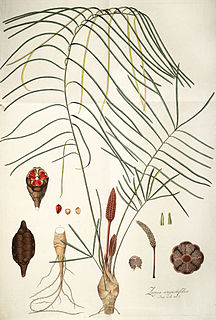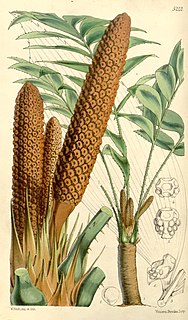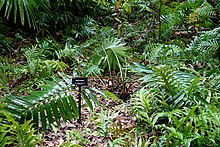
Zamia pumila, or coontie palm, is a small, tough, woody cycad of the West Indies. Zamia pumila was the first species described for the genus and hence is the type species for the genus Zamia and the family Zamiaceae.

Zamia is a genus of cycad of the family Zamiaceae, native to Mexico, the West Indies, and Central and South America as far south as Bolivia. The range of one species (Z. integrifolia, extends into the contiguous United States, i.e. Georgia and Florida.
The variegated butterfly bat is a species of vesper bat. It is sometimes also called the leaf-winged bat, or simply the butterfly bat. It is not currently endangered, but may be threatened by habitat loss in some parts of its range.

Zamia angustifolia is a species of plant in the family Zamiaceae. It is found in the Bahamas and Cuba. It is threatened by habitat loss.
Zamia cremnophila is a species of plant in the family Zamiaceae. It is endemic to the state of Tabasco in Mexico, between Teapa and Tapijulapa.

Zamia dressleri is a species of plant in the family family Zamiaceae. It is endemic to Panama, where it grows in rainforest habitat. It is found in Colón and Comarca de San Blas provinces.

Zamia fischeri is a species of cycad in the family Zamiaceae. It is endemic to Mexico. It is often confused with Zamia vazquezii. Zamia fischeri is named after Gustav Fischer, a cycad enthusiast of the nineteenth century.
Zamia lacandona is a species of plant in the family Zamiaceae. It is endemic to Mexico, where it occurs only in the state of Chiapas, near Palenque and Agua Azul.
Zamia melanorrhachis is a species of plant in the family Zamiaceae. It is native to Colombia and Peru. It is known commonly as corocito.
Zamia montana is a species of plant in the family Zamiaceae. It is endemic to Antioquia Department, Colombia. Its natural habitat is subtropical or tropical moist montane forests. Zamia montana is extremely rare and is unknown in cultivation. Its habitat is also extremely threatened by logging activities. In fact, it may well be extinct in the wild because the only known population occurs in an area that was recently logged.

Zamia portoricensis, the marunguey, is a species of plant in the family Zamiaceae. It is endemic to Susua State Forest region of western Puerto Rico.

Zamia purpurea is a species of plant in the family Zamiaceae. It is endemic to Mexico, where it occurs only in the states of Oaxaca and Veracruz. It grows in the understory of rainforests. It is affected by habitat destruction.

Zamia pygmaea is a species of plant in the family Zamiaceae found only in Cuba. It is the smallest living cycad. It is listed as critically endangered on the IUCN Red List based on its limited distribution, severely fragmented habitat, and population of less than 250 mature individuals.

Zamia skinneri is a species of plant in the family Zamiaceae. It is endemic to the coastal area of mainland Bocas del Toro Province, Panama. Its common name is cebolla roja.

Zamia standleyi is a species of plant in the family Zamiaceae. It is endemic to Honduras, and is threatened by habitat loss.

Zamia wallisii is a species of plant in the family family Zamiaceae. It is endemic to Colombia. Its common name is chigua.

The black-and-white ruffed lemur is an endangered species of ruffed lemur, one of two which are endemic to the island of Madagascar. Despite having a larger range than the red ruffed lemur, it has a much smaller population that is spread out, living in lower population densities and reproductively isolated. It also has less coverage and protection in large national parks than the red ruffed lemur. Three subspecies of black-and-white ruffed lemur have been recognized since the red ruffed lemur was elevated to species status in 2001.

Zamia erosa is a species of cycad native to the Caribbean islands of Jamaica, Cuba, and Puerto Rico, described by Orator Fuller Cook and Guy N. Collins in 1903. The species formerly known as Z. amblyphyllidia was determined in 2010 to be the same species as Z. erosa, and was. It is listed as vulnerable by the IUCN Red List.

Zamia integrifolia is a small, tough, woody cycad native to the southeast United States, the Bahamas, Cuba, the Cayman Islands, Hispaniola, and Puerto Rico. The species is possibly extinct in Puerto Rico and Haiti.















